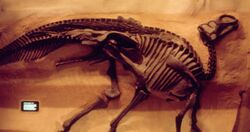Biology:Kritosaurini
| Kritosaurins | |
|---|---|

| |
| Gryposaurus notabilis skeleton at the Royal Ontario Museum | |
| Scientific classification | |
| Domain: | Eukaryota |
| Kingdom: | Animalia |
| Phylum: | Chordata |
| Clade: | Dinosauria |
| Clade: | †Ornithischia |
| Clade: | †Ornithopoda |
| Family: | †Hadrosauridae |
| Subfamily: | †Saurolophinae |
| Tribe: | †Kritosaurini Lapparent & Lavocat, 1955 |
| Type species | |
| Kritosaurus navajovius Brown, 1910
| |
| Subtaxa | |
| Synonyms | |
| |
Kritosaurini is a tribe of saurolophine hadrosaurid dinosaurs from the Late Cretaceous.
Discovery and naming
The first member of the group discovered and named was Kritosaurus; it was named by paleontologist Barnum Brown in 1910.[2] Four years later, Canadian paleontologist Lawrence Lambe would name Gryposaurus.[3] The similarity between the two taxa was immediately recognized, and throughout the twentieth century the validity of the latter genus was doubted, with it being suggested both species were the same.[4][5] Only in the 1990s were they definitively identified as distinct.[6] Around this time, related hadrosaurs Naashoibitosaurus[7] and Secernosaurus[8] were discovered, and the modern interpretation of the group started to develop.[9]
The name "Kritosaurini" was first mentioned in 1955 by Lapparent & Lavocat, where they mentioned "‘Kritosaurinés" as a group of hadrosaurids containing only Kritosaurus, which was thought of as a senior synonym of Gryposaurus. In 1989, Michael Brett-Surman proposed the name Kritosaurini as a tribe of hadrosaurines that contained Aralosaurus, Brachylophosaurus, Hadrosaurus, Lambeosaurinae, Saurolophinae, and Kritosaurus (including Gryposaurus).[9] It was not until 2014 that Albert Prieto-Márquez officially defined and diagnosed Kritosaurini as the most exclusive clade of hadrosaurids containing Kritosaurus navajovius, Gryposaurus notabilis, and Naashoibitosaurus ostromi.[10]
In 2022, Rozadilla et al. described Huallasaurus and Kelumapusaura, two new genera similar to kritosaurins. In their study, they analyzed the relationships of the Kritosaurini and Hadrosauridae as a whole.[11] In a study the following year, Alarcón-Muñoz et al. implemented an updated version of the phylogenetic matrix of Rozadilla et al, proposing the name Austrokritosauria for the clade of entirely South American saurolophines closely related to kritosaurins. The results of their phylogenetic analyses of Saurolophinae are displayed in the cladogram below.[12]
| Saurolophinae |
| ||||||||||||||||||||||||||||||||||||||||||||||||||||||||||||||||||||||||||||||||||||||||||||||||||||||||||||||||||||||||||||||||||||
See also
Notes
- ↑ Holtz, T. R. (2011). "Dinosaurs: The Most Complete, Up-to-Date Encyclopedia for Dinosaur Lovers of All Ages, Winter 2011 Appendix". http://www.geol.umd.edu/~tholtz/dinoappendix/HoltzappendixWinter2011.pdf.
- ↑ Brown, Barnum (1910). "The Cretaceous Ojo Alamo beds of New Mexico with description of the new dinosaur genus Kritosaurus". Bulletin of the American Museum of Natural History 28 (24): 267–274. http://digitallibrary.amnh.org/dspace/handle/2246/1398. Retrieved 2017-10-13.
- ↑ Lambe, Lawrence M. (1914). "On Gryposaurus notabilis, a new genus and species of trachodont dinosaur from the Belly River Formation of Alberta, with a description of the skull of Chasmosaurus belli". The Ottawa Naturalist 27 (11): 145–155.
- ↑ Brown, Barnum (1914). "Cretaceous Eocene correlation in New Mexico, Wyoming, Montana, Alberta". Geological Society of America Bulletin 25 (1): 355–380. doi:10.1130/gsab-25-355. Bibcode: 1914GSAB...25..355B. https://zenodo.org/record/1448379.
- ↑ Gilmore, Charles W. (1916). "Contributions to the geology and paleontology of San Juan County, New Mexico. 2. Vertebrate faunas of the Ojo Alamo, Kirtland and Fruitland Formations". United States Geological Survey Professional Paper 98-Q: 279–302.
- ↑ Weishampel, David B.; Horner, Jack R. (1990). "Hadrosauridae". in Weishampel, David B.. The Dinosauria (1st ed.). Berkeley: University of California Press. pp. 534–561. ISBN 978-0-520-06727-1.
- ↑ Hunt, Adrian P.; Lucas, Spencer G. (1993). "Cretaceous vertebrates of New Mexico". in Lucas, S.G.. Dinosaurs of New Mexico. New Mexico Museum of Natural History and Science Bulletin, 2. Albuquerque, New Mexico: New Mexico Museum of Natural History and Science. pp. 77–91.
- ↑ Brett-Surman, M. K. (1979). "Phylogeny and palaeobiogeography of hadrosaurian dinosaurs". Nature 277 (5697): 560–562. doi:10.1038/277560a0. Bibcode: 1979Natur.277..560B.
- ↑ 9.0 9.1 Brett-Surman, Michael Keith. (1989). "A revision of the Hadrosauridae (Reptilia: Ornithischia) and their evolution during the Campanian and Maastrichtian.". Faculty of the Graduate School of Arts and Sciences of the George Washington University.
- ↑ Prieto-Márquez, A. (2014). "Skeletal morphology of Kritosaurus navajovius (Dinosauria: Hadrosauridae) from the Late Cretaceous of the North American south-west, with an evaluation of the phylogenetic systematics and biogeography of Kritosaurini.". Journal of Systematic Palaeontology 12 (2): 133–175. doi:10.1080/14772019.2013.770417.
- ↑ Rozadilla, Sebastián; Brissón-Egli, Federico; Agnolín, Federico Lisandro; Aranciaga-Rolando, Alexis Mauro; Novas, Fernando Emilio (2022-02-24). "A new hadrosaurid (Dinosauria: Ornithischia) from the Late Cretaceous of northern Patagonia and the radiation of South American hadrosaurids". Journal of Systematic Palaeontology 19 (17): 1207–1235. doi:10.1080/14772019.2021.2020917. ISSN 1477-2019. https://doi.org/10.1080/14772019.2021.2020917.
- ↑ Alarcón-Muñoz, Jhonatan; Vargas, Alexander O.; Püschel, Hans P.; Soto-Acuña, Sergio; Manríquez, Leslie; Leppe, Marcelo; Kaluza, Jonatan; Milla, Verónica et al. (2023-06-16). "Relict duck-billed dinosaurs survived into the last age of the dinosaurs in subantarctic Chile" (in en). Science Advances 9 (24). doi:10.1126/sciadv.adg2456. ISSN 2375-2548.
Wikidata ☰ Q15516806 entry
 |

